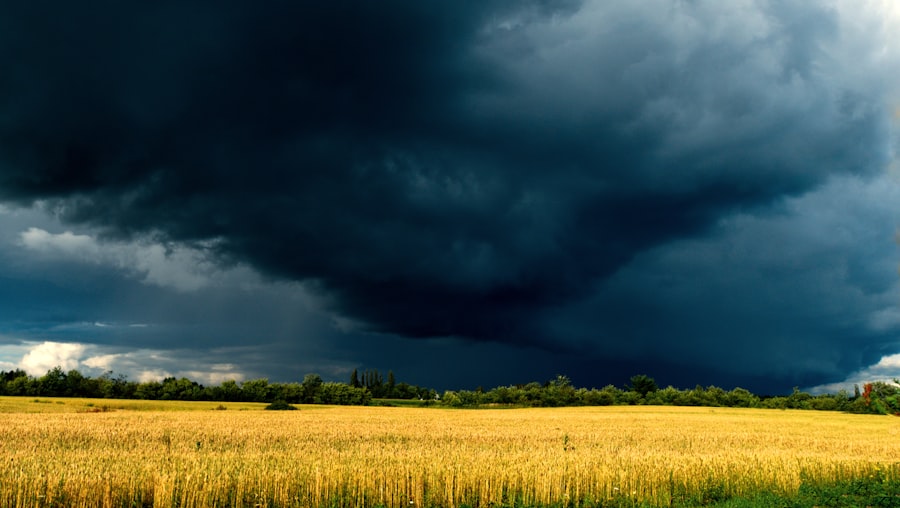Tornadoes are among nature’s most violent phenomena, characterized by their rapidly rotating columns of air that extend from thunderstorms to the ground. The formation of a tornado typically requires a specific set of atmospheric conditions, including warm, moist air near the surface, cooler, drier air aloft, and wind shear—changes in wind speed and direction with height. When these elements converge, they create an unstable environment conducive to severe thunderstorms, known as supercells.
Within these supercells, the updrafts can begin to rotate, leading to the development of a mesocyclone, which is a crucial precursor to tornado formation. As the mesocyclone intensifies, it can produce a funnel cloud that may eventually touch down, forming a tornado. The process is complex and can vary significantly from one tornado to another.
Factors such as terrain, humidity, and temperature gradients all play a role in determining whether a tornado will form and how powerful it will become. Understanding these dynamics is essential for meteorologists and researchers who seek to predict tornado occurrences and mitigate their impacts on communities.
The Importance of Tracking Tornadoes: Predicting and Preparing for Severe Weather
Tracking tornadoes is vital for public safety and disaster preparedness. Accurate predictions can save lives by providing timely warnings to those in the path of an impending tornado. Meteorologists utilize various tools and techniques to monitor weather patterns and identify conditions that may lead to tornado formation.
Moreover, tracking tornadoes allows for better preparedness at both individual and community levels. When people are aware of the risks associated with severe weather, they can take proactive measures to protect themselves and their property.
This includes having emergency plans in place, securing homes against potential damage, and staying informed through weather updates. The importance of tracking tornadoes extends beyond immediate safety; it also contributes to long-term resilience in the face of climate change and increasing weather volatility.
The Evolution of Tornado Tracking Technology: From Radar to Advanced Forecasting Models

The technology used for tracking tornadoes has evolved significantly over the decades. In the early days of meteorology, forecasters relied on basic observational methods and rudimentary instruments to detect severe weather. The introduction of radar technology in the mid-20th century marked a turning point in tornado tracking capabilities.
Doppler radar, in particular, allowed meteorologists to visualize storm structures and detect rotation within thunderstorms, providing critical information about potential tornado formation. As technology advanced, so did the sophistication of forecasting models. Today, meteorologists employ high-resolution numerical weather prediction models that simulate atmospheric conditions with remarkable accuracy.
These models integrate vast amounts of data from various sources, including satellite imagery and ground-based observations, to provide real-time insights into storm development. The combination of radar technology and advanced modeling has revolutionized tornado tracking, enabling forecasters to issue warnings with greater precision and lead time. Source: National Weather Service
The Ultimate Tornado Tracker: How It Works and What It Can Tell Us
| Category | Metrics |
|---|---|
| Tornado Intensity | EF-Scale Rating (Enhanced Fujita Scale) |
| Tornado Path | Length (in miles) |
| Width (in yards) | |
| Tornado Damage | Estimated Cost (in dollars) |
| Structures Destroyed |
The ultimate tornado tracker is a sophisticated system that combines multiple technologies to provide comprehensive monitoring of tornado activity. This system typically integrates Doppler radar data, satellite imagery, and ground-based observations to create a detailed picture of storm dynamics. By analyzing these data streams in real-time, meteorologists can identify areas of rotation within thunderstorms that may indicate the presence of a developing tornado.
In addition to detecting tornadoes, advanced tracking systems can also provide valuable information about storm intensity and potential paths. By utilizing algorithms that analyze historical data alongside current conditions, these systems can predict where a tornado is likely to travel and how strong it may become. This information is crucial for issuing timely warnings and helping communities prepare for potential impacts.
Real-Time Tornado Tracking: How Researchers and Meteorologists Use Data to Monitor Tornado Activity
Real-time tornado tracking relies on a network of technologies that continuously gather and analyze data related to severe weather events. Meteorologists utilize Doppler radar systems that can detect wind patterns within storms, allowing them to identify rotation indicative of tornado formation. Additionally, weather satellites provide crucial information about cloud cover, temperature variations, and moisture levels in the atmosphere.
Researchers also employ ground-based observation networks that include storm spotters—trained volunteers who report severe weather conditions as they occur. This grassroots effort enhances the data available to meteorologists and helps validate radar observations. By combining these various data sources, meteorologists can create a comprehensive view of ongoing tornado activity, enabling them to issue timely warnings and updates to affected communities.
The Role of Citizen Scientists: How Anyone Can Contribute to Tornado Tracking Efforts

Citizen scientists play an increasingly important role in tornado tracking efforts. These individuals contribute valuable observations and data that enhance the understanding of severe weather phenomena. Many communities have established programs that train volunteers to recognize signs of severe weather and report their findings to meteorological agencies.
This grassroots involvement not only bolsters data collection but also fosters a sense of community resilience. Moreover, advancements in technology have made it easier for citizen scientists to participate in tornado tracking initiatives. Mobile applications allow individuals to report real-time observations directly from their smartphones, providing meteorologists with immediate access to localized data.
This collaboration between professional meteorologists and citizen scientists enriches the overall understanding of tornado behavior and contributes to more effective forecasting efforts.
Improving Tornado Warning Systems: Using Tornado Tracking Data to Save Lives
The integration of tornado tracking data into warning systems has significantly improved public safety measures during severe weather events. By utilizing real-time data from radar systems and ground observations, meteorologists can issue more accurate warnings that specify the location and expected path of a tornado. This level of detail is crucial for ensuring that communities have enough time to take shelter or evacuate if necessary.
Furthermore, advancements in communication technology have enhanced the dissemination of tornado warnings. Alerts can now be sent via multiple channels, including text messages, social media platforms, and emergency alert systems. This multi-faceted approach ensures that individuals receive timely information regardless of their location or preferred communication method.
Ultimately, these improvements in warning systems have the potential to save lives by empowering individuals with the knowledge they need to respond effectively during severe weather events.
The Future of Tornado Tracking: Innovations and Advances in Tornado Prediction and Monitoring Technology
The future of tornado tracking holds great promise as innovations continue to emerge in meteorological science and technology. Researchers are exploring new methods for enhancing predictive capabilities through machine learning algorithms that analyze vast datasets for patterns indicative of tornado formation. These advancements could lead to even more accurate forecasts and earlier warnings for communities at risk.
Additionally, the integration of unmanned aerial vehicles (UAVs) into tornado research is gaining traction. These drones can be deployed into storm systems to collect real-time data on atmospheric conditions that contribute to tornado development. By providing insights from within storms themselves, UAVs could revolutionize the understanding of tornado dynamics and improve forecasting models.
As technology continues to evolve, the collaboration between meteorologists, researchers, citizen scientists, and advanced tracking systems will play a crucial role in enhancing tornado prediction and monitoring efforts. With ongoing advancements in data collection and analysis techniques, the goal remains clear: to minimize the impact of tornadoes on communities and save lives through improved forecasting capabilities.
If you are interested in learning more about tornado myths, be sure to check out the article on tornadoextreme.com. This article provides valuable information on common misconceptions about tornadoes and how to separate fact from fiction when it comes to these powerful natural disasters. It is a great resource for anyone looking to educate themselves on tornado safety and preparedness.

